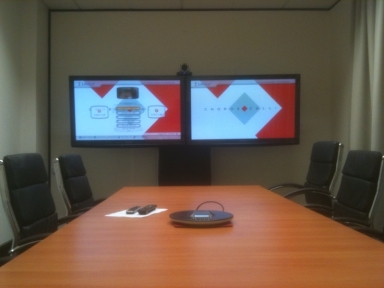 The Question: When will Video conferencing finally dominate over telephone conferencing?
The Question: When will Video conferencing finally dominate over telephone conferencing?The Background:For years people inside and out off the conferencing industry have been proclaiming the arrival of video conferencing into the Anglo markets. I say Anglo markets because much of video adoption has been a cultural issue. Japan already has a 90% penetration rate of video and uses it far more than just audio and this is largely due to the cultural issues of wanting to see the people they are dealing with. Angle nations do not have the same sensitivity and are driven more by ease of use and cost. I digress. Historically, video in a corporate environment have been hampered by the expensive Tandberg and Polycom units that they are convinced to invest in and many times end up gathering dust in board rooms. They were temperamental, badly supported and you needed to have a 18-23 year old at call to help you make a connection. It is widely known within most video support help desks that the busiest week in video support was the week after the Melbourne cup because the tv’s had been commandeered for the big race. For many large corporate and government departments the use of the tv was the most valuable aspect of the 30-50k systems hoisted upon them by IT teams wanting a toy.
Recently Cisco bet big on video in a couple of ways. Firstly there is Telepresence, a high definition and, quite frankly, an amazing video experience. The HD video monitors are moulded to the table to make it feel like the other site is actually sitting right across from you. The audio is great and the video the clearest you will see when working properly. It is so good I have found myself forgetting that it is video. But this experience is not cheap (multiple 100k’s) and the interoperability to other systems, while growing, is still very limited. The other aspects of Cisco’s bet is the purchase of Tandberg. Tandberg has the premium end of the video hardware market and worked hard to make sure that high end video clients can only use their expensive and IMO substandard equipment. Some of the ratios of this purchase seem crazy to me. The purchase price was over 22 times earnings, and a 25% premium on the three month closing average?! All this before Cisco had to up its offer another 10% to appease some investment funds who knew they had a gun to Cisco’s head with the requirement for 90% acceptance for the deal to become compulsory. While I have seen 3 or more Hollywood movies lately with nice product placement for Cisco video, their bet on Tandberg was badly timed and they will eventually write down a large portion of that investment, if they haven’t already.
The answer: Will we adopt video at a corporate level any time soon? I believe the answer to this is yes. For the first time technology is being driven by consumer requirements. Much to their horror IT and Security managers are being told by their executives to adapt the Iphone and Ipad platforms. This is being driven from a consumer experience of the platform wanting to have it available in corporate world. The same is set to happen with video. With Skype and the video chat functions of the IPad 2 executives will start to demand the same functionality for their businesses. Trying to hold back this tide are the hardware sellers, fearful of the software solutions (at a fraction of the price), and the IT managers worried about their capability to deliver such a huge amount of data.
The video we know of booking a time in the board room, having a service provider bridge 3 or 4 sites with much testing and expense will not be the model. The model will be software solutions where you can choose to deliver audio or video through an application on your desktop, smartphone or tablet with the click of a button. This solution is out there and being adopted at the flexible SMB now much to the consternation of the hardware sellers. I have tested 4 or 5 software solutions and while there are a variety of experiences and models being adopted, the simplicity, cost and flexibility is a compelling argument. The standards will be sorted out because interoperability is in everyone’s interest and it will quickly be adopted into larger corporate as bandwidth cheapens and executive demand continues to grow.
Voice and video will be delivered through the same applications with cloud based bridging either from service providers or the applications providers themselves. People will choose to allow video to be transmitted from their device of choice, or not, depending on their state of dress and if they want to do their email while someone prattles on. Unification is on the way.
The prediction:
In 5 years time the software video application sales will outweigh hardware unit sales 5000 to 1. We may see high end video units in conference centres but when you mention the words “video unit” to your child in 10 years their look will remind you of your reaction to the term 8-track. Sorry Cisco.
…Should Have Had a Chorus Call.


